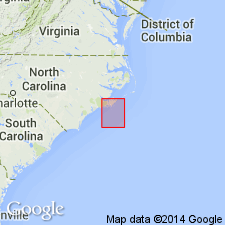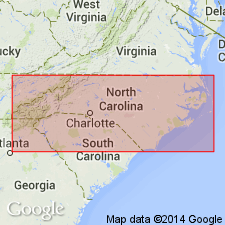
- Usage in publication:
-
- Beard Creek sand member*
- Modifications:
-
- First used
- AAPG geologic province:
-
- Atlantic Coast basin
Summary:
Flanner Beach Formation of Du Bar and Solliday (1963) adopted for use by the USGS and stratigraphically restricted to exclude their Minnesott Ridge sand and other younger Pleistocene beds. Includes three informally named members: Beard Creek silty sand member, Arapahoe sand member and correlative Newport sand member. Unconformably overlies Yorktown Formation. Age is Pleistocene (pre-Sangamonian?).
Source: GNU records (USGS DDS-6; Reston GNULEX).

- Usage in publication:
-
- Beard Creek Member
- Modifications:
-
- Named
- Dominant lithology:
-
- Sand
- Silt
- Clay
- AAPG geologic province:
-
- Atlantic Coast basin
Summary:
Estuarine and lagoonal backbarrier deposits in the Neuse River area of the NC Coastal Plain are here named the Beard Creek Member of the Flanner Beach Formation, following the informal usage of Mixon and Pilkey (1976). It consists of fine to medium sand and muddy sand containing mollusks and minor silt and clay interbeds. Gradationally and conformably overlies the Smith Gut Member of the Flanner Beach; intertongues to the east with the Arapahoe Sand Member of the Flanner Beach. Thickness is 4 m at type locality. Age is middle Pleistocene.
Source: GNU records (USGS DDS-6; Reston GNULEX).
For more information, please contact Nancy Stamm, Geologic Names Committee Secretary.
Asterisk (*) indicates published by U.S. Geological Survey authors.
"No current usage" (†) implies that a name has been abandoned or has fallen into disuse. Former usage and, if known, replacement name given in parentheses ( ).
Slash (/) indicates name conflicts with nomenclatural guidelines (CSN, 1933; ACSN, 1961, 1970; NACSN, 1983, 2005, 2021). May be explained within brackets ([ ]).

